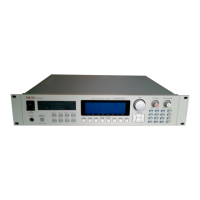INTRODUCTION
Page 16 S3000XL Operator’s Manual
Turning the DATA ENTRY ENCODER clockwise by one step now will increase the value of
the last highlighted digit, so:
Now if the -/> key is pressed once, the first four digits will be highlighted:
and turning the DATA ENTRY ENCODER one click clockwise will produce:
If you turn the DATA control more than ten clicks, of course, the value of the whole
parameter will be incremented or decremented by the number of clicks. In this way, with
very little effort, fast accurate editing of numbers can be achieved using only the +/< and
-/> keys and the DATA ENTRY ENCODER. The best way to learn how this works is to
practise; after a short time, it should become second nature.
On ‘signed’ fields (that is, fields that have a + or a - before them), the +/< and -/> will do
two things. Pressing the +/< key will move the cursor left within the field and, when it
reaches the furthermost left digit, you may use it to switch between + and - depending on
the selection you wish to make. The -/> key will move the cursor right and, when it reaches
the furthermost right digit you may toggle between + and - again.
As mentioned above, as an alternative to turning the DATA control, you can also use the
numeric keypad for direct entry of data. When you know the exact number you want to
enter, this can be faster than using the DATA control, but when experimenting (for
example, when setting loop points or sample start and end times), the DATA control may
be faster than the numeric keypad. You’ll probably discover quickly what method works
best for you in each situation.
NOTE: The cursor always stays on the last currently selected field in any screen. For
example, if you are in, say, the filter pages and are setting envelope 2’s depth and then
go to the ENV2 page to make an adjustment there, when you return to the filter page, the
cursor will still be on envelope 2’s depth parameter.
MARK AND JUMP KEYS
These two grey buttons to the right of the number keypad are used in conjunction with
each other.
JUMP/.
MARK/#
If you are carrying out editing operations which require changing display pages a lot,
these can save a lot of time and effort. Pressing the MARK/# button when the cursor is
on a field will cause the S3000XL to remember the position of the cursor, and pressing
JUMP/. will take the cursor back to the MARK(ed) position from any other page. Pressing
JUMP/. again will take you back to the page and function you were at before you
JUMP(ed).
You can reset the MARK position at any time. This position is lost when the power is
turned off. At power-on, this position defaults to the program select field in the initial
SINGLE mode.

